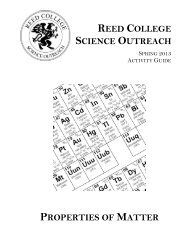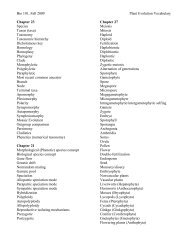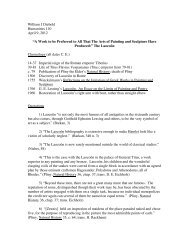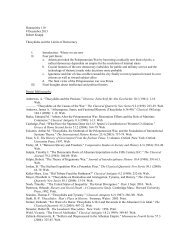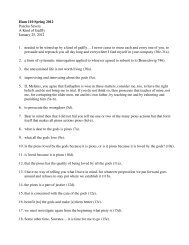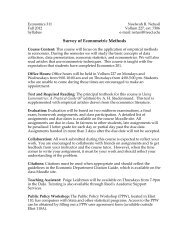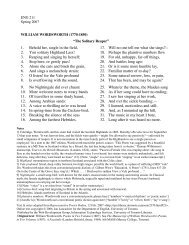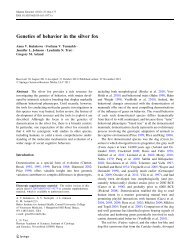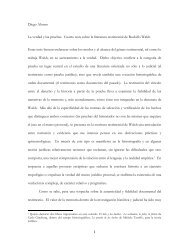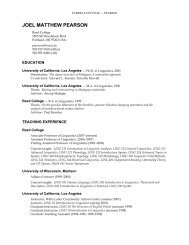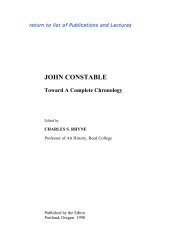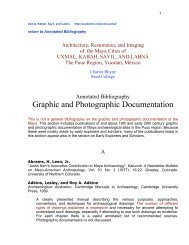Introduction Data Estimating the relationship between house value ...
Introduction Data Estimating the relationship between house value ...
Introduction Data Estimating the relationship between house value ...
Create successful ePaper yourself
Turn your PDF publications into a flip-book with our unique Google optimized e-Paper software.
1,621 square feet on smaller lots, supporting our result that failure to correct for lot size leads to an<br />
overestimation of <strong>the</strong> effect of <strong>house</strong> size.<br />
. by lgelot: summarize livarea<br />
--------------------------------------------------------------------------------------<br />
-<br />
-> lgelot = 0<br />
Variable | Obs Mean Std. Dev. Min Max<br />
-------------+--------------------------------------------------------<br />
livarea | 1405 16.21352 4.585679 7 49<br />
--------------------------------------------------------------------------------------<br />
-<br />
-> lgelot = 1<br />
Variable | Obs Mean Std. Dev. Min Max<br />
-------------+--------------------------------------------------------<br />
livarea | 95 24.63158 9.724998 8 48<br />
A logical way to compare <strong>the</strong> marginal effects of living space in <strong>the</strong> two subsamples is to<br />
evaluate each at <strong>the</strong> subsample mean. For large lots, <strong>the</strong> mean of LIVAREA is 24.63 and <strong>the</strong><br />
coefficient on LIVAREA 2 is 193.8, so <strong>the</strong> marginal effect evaluated at <strong>the</strong> mean is 2 × 193.8 × 24.63 =<br />
$9,549. For smaller lots, <strong>the</strong> corresponding calculation is 2 × 186.9 × 16.21 = $6,059. Thus, an<br />
additional 100 square foot room is worth much more if added to a <strong>house</strong> on a large lot than to one<br />
on a smaller lot.<br />
O<strong>the</strong>r determinants of <strong>house</strong> selling price (parts f and g)<br />
(f) The age of a <strong>house</strong> may also influence its selling price. The regression below shows that<br />
<strong>the</strong> linear <strong>relationship</strong> <strong>between</strong> selling price and age is negative: a <strong>house</strong> that is one year older is<br />
expected to sell for $627 less. The intercept of 137,404 could be interpreted as <strong>the</strong> expected selling<br />
price of a new <strong>house</strong> (AGE = 0). There are some <strong>house</strong>s of age zero in <strong>the</strong> sample, so this is not an<br />
out-of-sample extrapolation.<br />
. reg sprice age<br />
Source | SS df MS Number of obs = 1500<br />
-------------+------------------------------ F( 1, 1498) = 25.77<br />
Model | 1.0141e+11 1 1.0141e+11 Prob > F = 0.0000<br />
Residual | 5.8956e+12 1498 3.9357e+09 R-squared = 0.0169<br />
-------------+------------------------------ Adj R-squared = 0.0163<br />
Total | 5.9970e+12 1499 4.0007e+09 Root MSE = 62735<br />
------------------------------------------------------------------------------<br />
sprice | Coef. Std. Err. t P>|t| [95% Conf. Interval]<br />
-------------+----------------------------------------------------------------<br />
age | -627.161 123.5524 -5.08 0.000 -869.515 -384.8069<br />
_cons | 137403.6 3149.347 43.63 0.000 131226 143581.2<br />
------------------------------------------------------------------------------<br />
6



